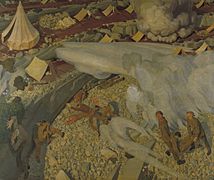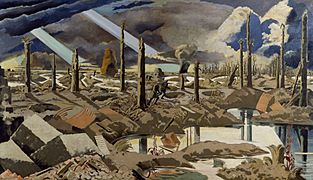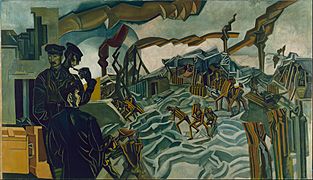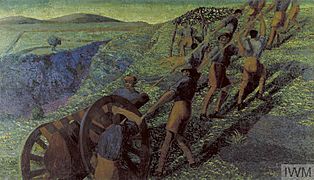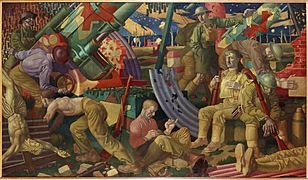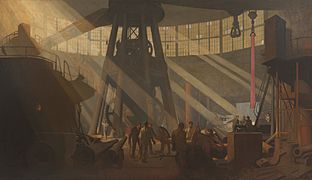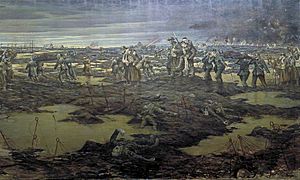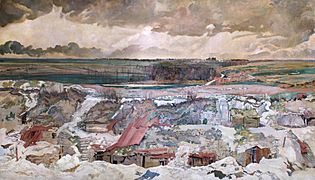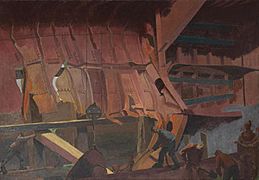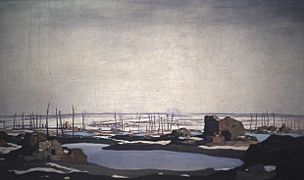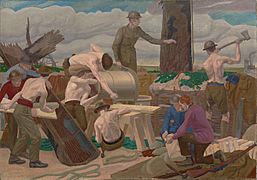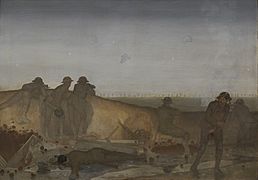Hall of Remembrance facts for kids
The Hall of Remembrance was a special collection of paintings and sculptures. It was created in 1918 to remember the soldiers who died in World War I. The British War Memorials Committee asked artists to make these artworks. This committee was part of the British government's Ministry of Information.
Creating the Hall of Remembrance
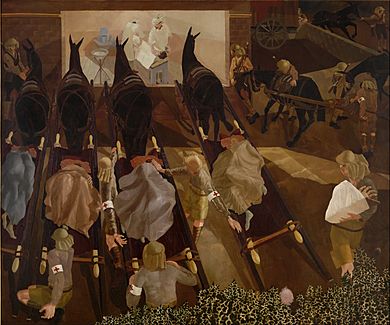
The idea for the Hall of Remembrance was to show different parts of the war. This included battles, life at home, and fighting at sea or in the air. The plan was to display these artworks in a special building. This building would be designed to fit large paintings. These paintings would be as big as the famous artwork The Battle of San Romano by Paolo Uccello.
The project was started by Lord Beaverbrook. He was the Minister of Information at the time. He had also started a similar art program for Canada. An architect named Charles Holden designed the building. However, the plan for the building was later stopped. The artworks that were already finished were not wasted. They were added to the art collection of the Imperial War Museum. Some artists like Muirhead Bone, William Orpen, and Sir John Lavery also donated their works.
The Unbuilt Hall
Even though the building was never built, we know a little about it. Charles Holden's plans are now lost. But Muirhead Bone described the building as a "kind of Pavilion." It would have been surrounded by a garden. A main gallery would lead to a special room called an oratory. This room was meant to celebrate "the coming Brotherhood of Man."
The Hall was supposed to have four very large paintings. These "super-pictures" would each be 20 feet long and 7 feet high. Each painting would show how Britain worked with its allies.
- William Orpen was asked to paint a picture about Britain and Italy. But he said no because he did not want to leave the war front.
- Augustus John agreed to paint a picture about Britain and France. This painting, called Junction of Our Lines with the French, was never finished.
- John Singer Sargent was asked to show cooperation between Britain and America. He visited the Somme battlefield but could not find a suitable scene. Instead, he painted Gassed.
- The fourth super-picture, showing troops from the British Empire, was never even ordered.
Artworks Created
Many important paintings were commissioned for the Hall of Remembrance. These artworks are now part of the Imperial War Museum's collection. They help us remember the events and people of World War I.
Here are some of the paintings that were completed for the Hall of Remembrance:
- Gassed by John Singer Sargent
- Travoys Arriving with Wounded at a Dressing Station at Smol, Macedonia, September 1916 by Stanley Spencer
- An Advanced Dressing Station in France, 1918 by Henry Tonks
- Irish Troops in the Judaen Hills Surprised by a Turkish Bombardment by Henry Lamb
- The Menin Road by Paul Nash
- Landing Survivors from a Torpedoed Ship by Walter Bayes
- Oppy Wood, 1917. Evening by John Nash
- A Battery Shelled by Percy Wyndham Lewis
- The Royal Field Artillery in Macedonia, Spring 1918 by Darsie Japp
- Heavy Artillery by Colin Gill
- In the Gun Factory at Woolwich Arsenal by George Clausen
- The Harvest of Battle by C R W Nevinson
- The Old German Front Line, Arras, 1916 by Charles Sims
- Divers at Work Repairing a Torpedoed Ship by John Laviers Wheatley
- The Battlefields of Ypres—After by David Young Cameron
- A Two Year-old Steel Works, 1918: erected during the War for Messer. Steel, Peech and Tozer Ltd., Phoenix Works, Rotherham by Charles John Holmes
- Erecting a Camouflage Tree by Leon Underwood
- A German Attack on a Wet Morning, April 1918 (1918) by Harold Sandys Williamson
-
The Menin Road by Paul Nash
-
A Battery Shelled by Wyndham Lewis
-
The Battlefields of Ypres—After by David Young Cameron


